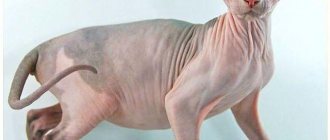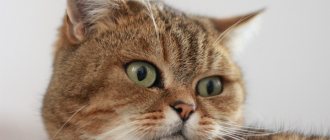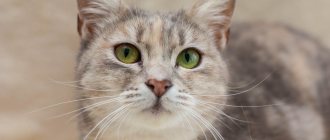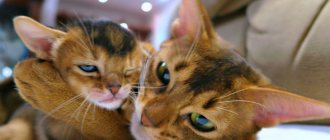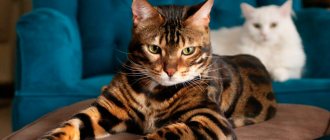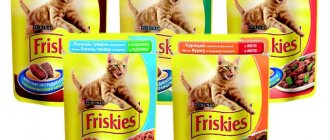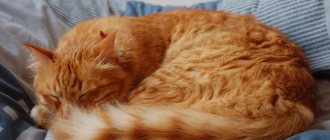Mixed cat, what does it mean?
Metis is not a cat breed. Such animals appear in a parent couple, where one is a representative of an elite breed, and the second is outbred. Another option is possible - when both parents are elite, but belong to different breeds. Crossing between them is allowed, and the litter acquires the qualities of the parent pair and is able to continue the race.
There is another concept - a cat hybrid. This means that individuals from different branches of the biological tree participated in the crossing. For example, a caracal from the Moscow Zoo mated with an ordinary cat, which subsequently gave birth to a healthy large kitten.
This event became a sensation in world felinology and forced a new look at the process of breeding hybrid cats. Thus, the Chausie breed appeared - a hybrid of the wild jungle cat Felis Chaus and the Abyssinian cat, and the Savannah - a mestizo cat bred by mating an African serval and a bengal.
Interesting facts about the Siamese cat
- The color of their coat is determined not only by heredity. This breed has a special modifier gene that prevents the development of pigment in the fur, which leads to albinism. Siamese are considered one of the oldest cat breeds in the world. Legends say that in ancient times the first Siamese cats were tasked with guarding the royal cup. They looked at him with such intensity that their eyes crossed. For added security, the cats wrapped their tails around the cup, causing them to become permanently bent. Siamese cats have appeared in many Hollywood films.
Overall, this is the most affectionate cat breed you will find. She is very smart, obedient and friendly, and also loves and values human communication so much that she is even called a cat-dog.
Advantages and disadvantages of mestizo
According to official data, there are 250 registered cat breeds. The total number of cats living throughout the globe is about half a billion. In addition to officially recognized breeds, there are also stray animals that are not included in the statistics. Random mating results in a huge population of mestizos. Whether this is good or bad is difficult to say, but we have identified several advantages and disadvantages of being mestizos.
Let's start with the pros:
- In the first generation, mixed-breed kittens receive the best characteristics of the parent pair, but later, unfortunately, they lose them.
- Mixed breeds are often healthy, but if one or both parents have an altered genotype, the kittens are more likely to be born sick.
- By purposefully crossing several breeds, it is possible to obtain an animal with a certain set of external qualities.
- The character also determines the genotype of the parental pair. A pampered Persian cat and a calm mongrel cat will not produce aggressive kittens.
As for the disadvantages, there are few of them - keeping a mestizo in the house is neither prestigious nor profitable.
Half-breeds do not have the right to participate in exhibitions, do not have a pedigree, are not allowed to crossbreed with elite animals, and there is no queue of people who want to get a purebred pet. However, cat lovers in most cases do not pay attention to such nuances and happily take outbred animals from the shelter.
Tips for choosing a mixed-breed kitten
Since in the category of mestizos there are no clear requirements for breed qualities, when choosing a pet you should pay attention to other characteristics:
- In a mixture of a British Shorthair and a regular cat, it is worth studying the animal's coat - the variety of colors sometimes leads to very unusual combinations and shapes. Each kitten will eventually find its owner, but not every owner wants to get a pet with an unusual color. For example, there are people who categorically do not accept black cats of any breed, while others intuitively avoid tortoiseshell coloring.
- A mixed Siamese and British cat kitten may be born with thin “Siamese” paws. If a pet inherits a powerful body from a Briton, then it will be difficult for him to maintain a lot of weight. This may manifest itself as stiffness of movement during games. In the future, this symptom may disappear or develop into a serious problem with the musculoskeletal system.
- An objective indicator of an animal’s good condition is its fur. If it bulges, does not lie flat, clumps into small icicles and does not shine, it means the kitten has health problems.
This is interesting! Mixed breeds have a low threshold for reblooming. The color tone, which is established by 3-4 months, as a rule, does not change later.
Metis with British
The British cat is an indigenous breed with an ancient history of development, which begins in the days of the Roman legionnaires. These animals are endowed with refined manners, prefer solitude, do not like noisy companies and too active games. The most common crosses of British cats are with ordinary cats, with Toygers and with Siamese.
A mix of a British cat and a regular cat
Outbred cats have an amazing ability to quickly adapt to their environment. These animals are independent, unpretentious, endowed with excellent hunting skills that allow them not to die of hunger, which cannot be said about most purebred domestic cats.
It is worth noting that street cats do not strive for privacy; they are sociable and do not mind contact with people if they behave kindly. Animals that are brought into the home at an early age are socialized no worse than purebred cats.
Mixed breeds of a British cat and a regular one are most common. Sometimes at first glance it is even difficult to distinguish who is who. Half-breeds have the same massive bone structure and broad chest, but are slightly smaller in size. Developed cheeks make the muzzle round.
Coat colors are varied. The British are characterized by about 200 colors, so the color options for mixed breeds are unlimited. There are individuals with a color-point mask like the Siamese or spectacular silver chinchilla ticking.
The Métis partly adopt the British desire for privacy. Such animals are more eager to be the center of attention; they are quite sociable and responsive.
Interesting. At an early age, half-breeds exhibit to a greater extent the manners of mongrel animals, and in adulthood they show prudence and sedateness - qualities inherent in the British breed.
Toyger/British mix
Mixed Toyger + British cat is an animal with a clear striped pattern on its fur. The Toyger breed was developed relatively recently and received admission to the exhibition career in 2007. These cats are characterized by the only so-called brindle color.
Toygers are much thinner than the British, have an elongated body and long legs. Mestizos are distinguished by an average constitution, proportional physique, and a beautiful fur coat with a tabba pattern. The bands may be clear or blurred, but are present in 95% of cases.
The character of half-breeds is more reminiscent of the British. They are just as prim and calm. Second-generation mestizos resemble only one of their parents.
Mix of Siamese and British cat
Mixed breeds of British and Siamese cats are spectacular beauties with a solid color, for which the C gene is responsible, which is involved in the formation of the color point color.
The Siamese color depends on the animal's body temperature. The body of cats is warmer, so the gene does not appear in this part of the body. The fur on the body is always light. The limbs, ears, muzzle and tail are cooler, so the coat is darker in these areas. The British are also characterized by the Siamese color, which is inherited.
A cross between a Siamese and a Briton looks heavy, has a massive bone structure and a wide chest, long legs and a tail.
Kittens inherit an independent character and egocentrism (from the British), resentment and rancor (from the Siamese). The British genotype is considered dominant, which is often expressed in complete resemblance to the aristocratic breed.
Seychelles
The homeland of these graceful animals is Great Britain. In the 70-80s of the last century, the British set out to breed a new breed of cats. With the blessing of the British Cat Association, breeders began work on crossing Siamese and Persian cats. The result is the appearance of Seychelles cats.
He has an aristocratic appearance, good manners and great demands. They will never allow themselves to be treated with disrespect. Seychelles cats differ from Siamese cats by having large ears of a non-standard shape. Like all representatives of oriental breeds, these cats create the impression of exaggerated elegance. In fact, they are quite strong and muscular.
Note: The Seychelles cat is a domestic breed; it is very difficult for her to tolerate travel and any change of environment.
Maine Coon mixes
The Maine Coon is a large-sized native cat breed. The animals are distinguished by their massive build, strong bones, angular contoured muzzle, and large ears with tufts. Colors can be any: cinnamon, lilac, chocolate and fawn, solid.
The coat is thick, water-repellent, and the undercoat is soft. The neck is decorated with a frill. The tail is long, wide at the base, tapering to the tip, covered with long hair. The eyes are oval, expressive, the color of the iris matches the color of the coat.
Breeding Maine Coon mestizos is officially prohibited, but in reality this issue is not controlled. Amateur breeders often breed Maine Coons with other cat breeds. Half-breeds are much cheaper, which increases the demand for them.
In specialized nurseries, cull cats are not sold for breeding, but they can be purchased as a pet. Such animals must be castrated or sterilized.
It is also important to remember that a purebred Maine Coon and a mixed breed are completely different animals. A half-breed will never meet the breed standard. The appearance of such cats is very diverse and depends on the genotype of the parents.
Purebred Maine Coons are endowed with the following qualities:
- goodwill;
- agreeableness;
- sociability;
- devotion;
- prudence.
When crossed with a regular cat, these traits change or disappear completely.
As for external qualities, purebreds must have tufted ears, an elongated muzzle, massive paws, and a long fluffy tail. Three-month-old kittens should weigh at least 2.5 kg (the cubs of an ordinary cat at this age weigh no more than 1 kg). The body length of adult males is approximately 1 m and weight is 11 kg.
As for attempts to crossbreed the Maine Coon with other breeds, they all failed. The purpose of such experiments was the desire to add some qualities from other breeds to Maine Coons. For example, to produce a big cat of an unusual color, a female Maine Coon was bred with a male Siamese breed. However, the experiment was unsuccessful - kittens of different sizes were born in the litter.
When mated with Persians, the result was large kittens with fluffy red fur without the slightest hint of resemblance to Maine Coons. An attempt to crossbreed with a Bengal to increase body size also failed.
Maine Coon and Siberian kittens are similar in appearance to purebreds, but are of medium size. Such babies are often passed off as noble, but they are sold at a discount and without a pedigree.
A mixed breed of a Maine Coon and a domestic cat was obtained completely by accident. The baby retained the color of his coat, but lost a number of positive character traits.
Maine Coons are also crossed with Britons, Neva Masquerade and other breeds of cats, producing litters with fur of different lengths.
Description of the Siamese breed
Let's look at the appearance and character of Siamese according to the breed standard.
Standard
Siamese cats are well balanced, boasting an athletic, flexible body and elegant, slender legs.
The breed standard for the modern Siamese cat assumes:
- Body: Elongated, tubular and muscular. A typical Siamese cat has a total height of 20-25 cm and a body length of 29-36 cm, with a body weight of 4-5 kg. Head: Straight profile with a strong chin and a pleasant, even bite. The head forms a perfect triangle from the tip of the nose to each tip of the ear. The neck is long. The eyes are almond-shaped, bright blue, and the ears are large, wide, located closer to the head. Limbs: The cat's hind legs are longer than her front legs, which adds to her athletic and graceful appearance. The paws are oval shaped and small. Thin tail. Coat: Short, shiny, fine coat without undercoat that lies close to the body.
Today, there are over 20 varieties of Siamese cat colors all over the world, and the most famous of them are:
- Seal point (brown or cream), with a cream-colored body and dark brown pigments on the nose and paws. It is believed that this was the original color of the breed when it was first exported from Siam (Thailand). Blue Point (blue) - the body is snow-white with a bluish tint, as well as a gray nose and paws. The Red Point is a white body with red (apricot) pigments on the nose and paws. The Caramel Point (light cream) is considered a hybrid due to a complex breeding process, with very light and pink pigments on the nose and paws. Chocolate point (black). The body is cream or milky in color, and the pigments on the points can range from chocolate to black. Cinnamon point (ivory). The body is ivory-colored, like a Chocolate Point, but the markings on the nose and paws are pinkish-brown.
Photos of colors
Mixed bengal cat
The Bengal cat is a cross between a domestic cat and an Asian leopard. Mating Bengals with other breeds is prohibited by all felinological organizations. There are no recognized crossbreeds of this breed, but this does not prevent unscrupulous breeders from crossing Bengals with other breeds or ordinary cats. As a result, mestizos with a variety of colors appear. The second generation completely loses the characteristics of its parents.
Recently, long-haired Bengals have become especially popular; they retain the characteristics of the breed, but have long hair, a fluffy collar and tail.
If earlier breeders sterilized such animals, now the long-haired variety is valued higher than the traditional Bengal cat.
How to choose the right kitten
In order not to make a mistake when choosing a pet, it is not enough to listen only to your inner instinct. Experts advise following the basic rules:
Ask the breeder about all the offspring to determine whether the kittens are suitable: where they grew up, what their character is, whether they were examined by a veterinarian, whether the kittens were picked up after two weeks of age. Have any preventive treatments and vaccinations been carried out? First look at mom. If the kittens are from a nursery, then you should find out as much as possible about the parents. You should not take obstinate representatives who hiss and scratch.
A healthy animal can be identified by the following signs:
- clear eyes without discharge; clean area under the tail; shine of wool; absence of bloating - the first sign of helminthiasis; energy and curiosity; communication with brothers; fearlessness.
Any kitten - purebred, mestizo or mongrel - can become the best friend and companion. He will reciprocate the sincere love and care of the owner. You should not chase expensive, fashionable and purebred cats; it is better to bring into your home a faithful and devoted companion who will not leave you in difficult times and will brighten up the melancholy of gray everyday life.
Persian cat mixes
The Persian cat is one of the most popular breeds in the world. The variability of colors is amazing; in this regard, Persians have no equal. In this regard, the number of Persian cat mestizos is growing steadily. The most widespread is the cross between the Persian and the British. Mixes of an ordinary cat and a Persian are often found. Of particular value are the Scottish Fold and Persian half-breeds.
Persian cats are often used to develop new breeds. One of these is an exotic cat. Externally, the exotic resembles a Persian, but has short hair.
Other famous breeds derived from the Persian cat:
- Napoleon - a mixture of a Persian and a Munchkin;
- Himalayan - a cross between a Persian and a Siamese;
- Cherub - a curly-haired Selkirk Rex with the face of a Persian cat;
- Tiffany - a mix with a Burmese, with an unusually soft and silky coat;
- The Alaskan Snow Cat is a cross between a Somali and a White Persian.
Reference. Interspecific crossing does not affect the health of mixed-breed Persians and other cats, except for the risk of genetic diseases.
Metis or mongrel?
True purebred cats are significantly inferior in number to outbred and mestizo cats, the difference between which lies not only in color, but also in behavior and health. As a result of family ties that were carried out for improvement, purebred cats have numerous mutations and a number of congenital pathologies. Mestizos and outbreds are distinguished by stronger physical characteristics and immunity.
Outbred cats often have short hair, which helps with hygiene. The most common color is brindle, but tortoiseshell, blue, spotted and solid are also found. According to their external characteristics, yard cats can be divided into northern and southern types. Those living in the north are distinguished by thicker, lighter hair and stocky, large physiques, while those living in the south are darker, smoother and more graceful.
A mixed-breed cat is also a mongrel cat, but has the characteristic features of purebred cats. This is manifested in color and physique, character and health. Mixed breeds have a chance to get the breed. To do this, the owners need to breed offspring from a mixed-breed parent couple (not father and mother, but of the same breeds) and cross the offspring with each other. And only the fifth generation can become a contender for thoroughbred.
We choose by appearance and character
Every cat is unique. However, experts say that a pet’s character and susceptibility to diseases can be predicted by its external features. Mixed breeds of elite cats inherit the exterior and temperament that are characteristic of a particular breed. When choosing a mestizo, pay attention to the phenotype.
"Marquise" phenotype
Such animals are characterized by the following features: short black hair with white spots, a dense body constitution in males, and graceful in females. The phenotype is most often found in short-haired European breeds. Such animals have a stable and quite predictable character. Cats clearly demonstrate their intentions and achieve what they want with perseverance and affection.
Phenotype "Siberian cat"
This phenotype is characterized by a gray color and striped pattern, long hair and thick undercoat, a loose or dense body, a large head, and an elongated muzzle. Character is independent, self-sufficient. These cats walk on their own, define the role of the owner and make it clear what place they occupy in the house. They accept affection at will or according to their mood; they do not like calf tenderness.
Angora cat phenotype
Representatives of this phenotype are distinguished by long or semi-long hair of light shades, have a dry body, and an elegant head. Despite their independent disposition, cats are immensely loyal to their owner, however, sensing a person’s weakness, they are capable of showing aggression. Animals need constant contact with a person from whom they expect stability.
Phenotype "Persian cat"
These animals have long, silky hair without coarse guard hairs, a round head and flattened nose, and a loose or coarse body constitution. Cats demonstrate an independent character, consider themselves the main decoration of the house, and are often capricious. Mixed breeds are often cut like a lion, which makes it easier to care for their long hair.
Phenotype "oriental cat"
These cats are born with short hair, thin and dense bones, developed muscles, and large mobile ears. With an elegant appearance, representatives of this phenotype are quite heavy. Various colors: solid, spotted, striped, tabby, color point. Cats are human-oriented and have a need for regular communication, which is why they received the nickname “cat-dog.” Animals are very energetic, need active games, and try to establish their own rules in the house.
Phenotype "Thai cat"
Representatives of the phenotype have semi-long or short hair. Colors: lilac tabby point, blue point, seal point, lilac point. The color of the iris is exclusively blue. The constitution is dense, but not rough. The character is balanced, calm, non-conflict. The behavior pattern resembles that of a dog. Cats sense their owner's mood swings and are very persistent in achieving goals. They achieve their goals with persistence and affection.
"British" phenotype
This phenotype is characterized by dense and short fur, a round head, erect ears, a rough constitution, and a thick tail with stripes. Common colors are tabby and blue-gray. The character of these animals is independent and stubborn. When achieving what they want, they often show aggression; they do not like to sit on their owner’s lap; they allow themselves to be petted if they are in the mood, otherwise it is better not to approach.
Difference in character
The breeds differ not only in appearance, but also in disposition. Siamese are more sociable and good-natured; they love the company of people and do not welcome loneliness. Siamese cats have a very shrill and loud voice; they love to complain to their owners and purr on their laps about their cat's lot. To these characteristics should be added the playfulness and very active lifestyle of the Siamese: the Siamese cat prefers to spend most of its time playing.
The Siamese's playfulness continues into old age.
Thai cats are calmer and are often described in one word – wise. They are calmer, no less friendly, and prefer to spend time alone next to their owner. They love to observe and create the world around them without unnecessary noise. They do not like to show aggression and get along well with other pets. Thais also do not like loneliness, but if the Siamese begin to loudly express their dissatisfaction, then the Thais become withdrawn and irritable.
Thais are calmer and often prefer peaceful sleep to noisy pastimes.
Nutritional Features
The diet of mestizos is no different from the diet of purebred cats. Considering that felines are obligate animals, the main ingredient in their menu should be meat. In second place are animal fats, in third place are carbohydrates in minimal quantities.
Cats can be fed natural foods:
- rabbit or lamb meat;
- chicken;
- turkey;
- veal;
- chicken giblets;
- sea fish;
- greens;
- fresh vegetables;
- eggs;
- fermented milk products.
You should not give salted, fried, spicy, sweet foods, whole milk, river bony fish, tubular bones. Forbidden delicacies cause excess weight gain, metabolic disorders, and failure of the endocrine, cardiovascular, and urinary systems. Buy treats at veterinary pharmacies or pet stores.
Meals are selected individually. Energy value and nutrient requirements depend on:
- physiological state of the cat (pregnancy, castrated and sterilized animals);
- body weight, constitution;
- health conditions;
- age;
- conditions of detention;
- activity level.
If your choice falls towards dry food, buy premium and super-premium products, as well as dried and canned food labeled holistic. Holistic food contains natural meat and fish, vegetables, berries, fruits and herbs. They do not contain artificial additives to improve taste and smell, unlike economy class feeds.
Attitude towards children
By nature, Thai cats are sociable and socially adapted to living in a family with other animals and small children. They, unlike Siamese, will find an approach to all family members; when with children, they will not let out their claws even in a game of chance, and will patiently endure squeezing and annoying caresses.
In addition, Thais are a “talkative” breed of cats: when their owner addresses them, they make funny sounds in response, maintaining a conversation. Sometimes they “chat” incessantly, so those who like silence in the house are better off getting a more phlegmatic breed.
Unlike Thais, Siamese are individuals who become attached to one owner; they are jealous, and this negative character trait sometimes extends to children. If a Siamese is given less attention than children, he will harbor resentment and will not make contact with younger family members.
Both Siamese and Thai breeds are recommended for those who are able to spend a lot of time with their pets.
Caring for Mestizos
Recommendations for caring for half-breeds are the same as for purebred cats:
- Long-haired animals need to be combed daily, especially carefully during seasonal shedding. Short-haired cats are combed 2-3 times a week using a furminator, comb, or stiff brush. Persians should not be scratched with a slicker brush, which will damage the delicate hairs.
- Shampoos and conditioners for long-haired cats are used for bathing. Considering the dislike of cats for bathing, with the exception of Maine Coons, this should be done in case of emergency. Cats are clean creatures and are able to keep their coats clean on their own.
- The eyes and ears are examined once a week and cleaned with special lotions or clean water. Persians, like mixed breeds, collect discharge in the inner corners of their eyes that must be removed daily to prevent the risk of developing a bacterial infection.
- Animals should have special rodents freely available to remove plaque.
- A nail clipper is used to trim claws. The procedure is performed carefully, trying not to touch the blood vessels.
It is important to keep the tray clean. The filler can be anything: wood, clay, clumping, silica gel. Some cats eat silica gel granules for some unknown reason. If you notice that your pet is partial to this filler, change it to another one. It is advisable to change the wood one every two days or daily.
Care and maintenance
To properly care for a mestizo, you need to know from which parents he was born. If several varieties of purebred genes are mixed in the kitten’s blood, then the best adviser on keeping the animal will be the breeder, who will tell you what nuances you need to pay attention to.
If the animals do not require special care, then standard procedures are carried out:
- inspect for fleas;
- get rid of all parasites;
- get vaccinated;
- carry out sterilization.
Cats have their teeth and ears cleaned and their fur combed once every 10-14 days. Bath felines if necessary.
Additional information: Cats can suffer from a variety of infectious diseases. The most dangerous are: rabies, feline distemper, calcivirus, coronaviruses.
The appearance of vomiting, diarrhea, and ulcers on the body should be an immediate reason to contact a veterinary hospital.
Hybrid kittens of the Russian blue breed
Mestizo nutrition
Animals are not fed what humans eat. The dishes may contain products, the excess of which will be harmful to animals. It is rational to use special food for cats that contains the vitamins, minerals, and trace elements necessary for animals. Boiled meat, fish, vegetables, and low-fat milk are added to them. Cats should not be given sweets, smoked or salty foods.
Water is an integral part of food for animals. It must be clean, non-chlorinated. It is better to use drinking purified water. The dishes from which cats eat should always be thoroughly washed, and they should be boiled or disinfected at least once a week.
Recently, cat breeds have changed a lot, so the appearance of all kinds of crossbreeds has become commonplace. Some of them have body features and coat color that have become very exotic and unusual. Those who like to modify animals should always remember that animals are loved not so much for their appearance, but for their gentle purring and unobtrusive presence.
By Administrator | 12/22/2019 | No comments | Kitten nutrition
Diseases, their prevention and treatment
Mixed-breed cats are generally healthy animals; their susceptibility to diseases depends on their phenotype:
- The “marquise” phenotype has excellent health, but if there is a malnutrition, urolithiasis develops.
- Representatives of the “Siberian cat” phenotype often experience digestive difficulties and are prone to rapid weight gain, diabetes and urolithiasis.
- Angoras have good health, but some individuals have breathing problems.
- In the “Persian” phenotype, diseases of the upper respiratory tract and genitourinary system are observed.
- Representatives of the “oriental” phenotype rarely get sick, but sometimes they are diagnosed with gastrointestinal diseases.
- “Thais” have good health, but some individuals are predisposed to urolithiasis and infectious diseases.
- “The British” are prone to chronic kidney disease, obesity, and suffer from endocrine system disruption and chronic pancreatitis.
Treatment is prescribed exclusively by a veterinarian after a series of diagnostic and laboratory tests.
Prevention of infectious diseases involves timely vaccination, which must be carried out even if your pet does not go for walks in the yard. We bring viruses and bacteria home on the soles of our shoes; mating with animals without a veterinary passport means an increased risk of contracting a genitourinary infection.
According to the vaccination calendar, pets are vaccinated according to age against the following diseases:
- Rabies is an infectious disease that has no cure. Carried by infected animals and rodents.
- Rhinotracheitis is a herpesvirus infection that affects the respiratory system and eyes. Characterized by an acute course. Carriers are sick cats.
- Calcivirosis is an infectious disease transmitted from other cats. Mortality is more than 80%.
- Peritonitis is a disease caused by coronavirus. The route of infection is airborne. Mortality is more than 90%.
- Panleukopenia or feline distemper. – an acute viral disease transmitted from sick cats. Difficult to treat, leads to death in 90% of cases.
- Chlamydia is an infectious disease characterized by a long course, transmitted by birds and rodents, and affects the genitourinary, visual, respiratory, and digestive systems.
- Microsporia or ringworm is a skin disease transmitted from sick animals, as well as from cats to humans.
Vaccination calendar:
- Panleukopenia, chlamydia, calcivirosis, rhinotracheitis - at 8 weeks, revaccination at 10-12 weeks, then annually.
- Rabies - at 12 weeks, revaccination every year.
- Microsporia - at 8 weeks, revaccination after 14 days, then annually.
- Viral peritonitis - at 16 weeks, revaccination after 4 weeks, then every year.
Care instructions
If a mixed breed is nevertheless purchased, the first thing you need to do is show it to a professional veterinarian, determine the vaccination schedule and sterilization date, and also identify the individual’s defects.
Based on the doctor's opinion, care will be determined.
If everything is relatively fine with the kitten, then the care recommendations are practically no different from keeping purebred cats, namely:
- daily combing with a furminator during the period of active molting; Using shampoo and conditioner for long-haired cats while bathing; a diet of raw beef, boiled chicken and rabbit than purchased food; milk is prohibited; sour cream, kefir and cottage cheese are useful; premium jelly food is allowed, but there is a chance that the cat will then refuse natural food; It is recommended to wash your eyes daily with a special composition to avoid infection; The animal must have special toys freely available to remove plaque; weekly cleaning of the ears with cotton pads soaked in a special lotion; weekly manicure (the first procedure is recommended to be carried out by a specialist, who will also show how to do it correctly without touching the blood vessels); if the mixed breed is large, a large tray is needed.
It is necessary to buy any purebred purebred cat when it reaches the age of 3.5 months - it is at this age that almost all defects are discovered, and purebred Maine Coon cats grow tufts on their ears. The pedigree of a real Maine Coon should indicate 4 generations of his ancestors and their exhibition achievements, and also remember that purebred cats are never sold at discounts (a culled individual is usually only one in a litter and costs 2–3 times less, and not by 10%).
To learn how to determine the purebred of a Maine Coon, watch the video below.
There is very little difference between outbred cats and mestizos. They do not have documents about their origin, but the former are born from the same parents, and the latter most often appear as a result of human carelessness. Nature cannot be changed, and a purebred cat is not always selective in choosing a gentleman.
In rare cases, we are talking about targeted experimental breeding, when professional breeders and breeders conjure to improve an existing species or form a new breed.
